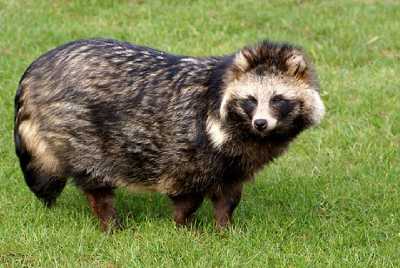 SKC Films Library SKC Films Library |
| SKC Films Library >> Science >> Zoology >> Mammals >> Order Carnivora >> Family Canidae |
| Raccoon Dog Nyctereutes procyonoides Description Despite its name, the only direct relationship between the raccoon dog and the raccoon is appearance -- stocky body, short legs, general coloration, and black facial mask. And, although it is a member of the dog family, the raccoon dog is more closely related to foxes than to domestic dogs. It has curved claws that allow it to climb trees, making it the only canid capable of climbing trees other than the grey fox.
An adult raccoon dog is 19-27 inches long, including the tail, and weighs 8-22 pounds; females are typically larger than males. Distribution and Habitat Native to eastern Siberia, northern China, North Vietnam, Korea, and Japan, the raccoon dog was introduced into Europe by the fur-farming industry between 1927 and 1957 and is now widespread throughout central and eastern Europe. Found in subarctic and subtropical climates, it prefers forests, forest borders, or areas of dense vegetation, especially those bordering water. Raccoon dogs can be found from sea level to altitudes over 9,800 feet. Habits and Behaviors Raccoon dogs appear to live and hunt in pairs or small family groups, but it is unknown whether those pairs and family groups stay together year-round. Unlike other canids, raccoon dogs are neither social nor territorial. Although invividual home ranges frequently overlap, neighboring raccoon dogs rarely interact and there has never been a documented case of two raccoon dogs fighting over the same territory. Individuals that share a common home range do "keep in touch" with one another, however, by sharing a common latrine area. Raccoon dogs use the latrine for information exchange among family members as well strangers. The animals modify their behavior based on olfactory recognition of specific individuals when they encounter one another. Raccoon dogs do not bark, but they will whine, whimper, or mew when being friendly or submissive, and may growl when frightened or when being aggressive. They also use use some body postures--such as tail position--to indicate dominance and readiness to mate. Although they are primarily nocturnal, raccoon dogs will extend their period of activity into the dusk and dawn hours if they need to find food. Hibernation is not absolutely necessary for this species. If an individual is unable to store enough fat beforehand, it will have to emerge from the den on warm winter days to forage. For this reason, some individuals may not hibernate at all. In the southernmost part of the range, raccoon dogs do not hibernate. Where it does occur, hibernation begins in November and may extend through early April, depending on the local climate. Diet Like its namesake, the raccoon dog is an opportunistic omnivore. On land, it hunts insects, small rodents, reptiles and amphibians, birds, and eggs. It will fish in lakes, rivers, and streams using its paws to scoop prey out of the water, and will even dive underwater in search of a meal. On the seashore, it will feed on crabs, sea urchins, and sea carrion. Raccoon dogs also eat a variety of plant materials -- stems, roots, leaves, bulbs, fruits, nuts, berries, and seeds. And, in keeping with its "raccoon reputation," a raccoon dog is not above scrounging through human garbage or feeding on carrion when its "normal" food is in short supply. Reproduction Females come into heat once a year, between January and March, depending on geographic location and whether or not they have hibernated. While in estrus, the female will be courted by 3-4 males, but how the final mating pair is formed is not known. Once formed, a breeding pair will stay together until the young are independent; whether pairs reform year after year has yet to be determined. Gestation lasts 59-64 days, during which time the male brings food to the female. Birth usually takes place either in dense vegetation or in an abandoned fox or badger burrow. The 5-7 pups are born blind; their eyes will open on their 9th or 10th day, and teeth will begin to show by 14 to 16 days. The male will continue to bring food for the mother until the pups are weaned, which happens between 30 and 40 days of age. It takes another 50-55 days for the pups to become independent, during which time the entire family will hunt for food together. Raccoon dogs appear to reach sexual maturity at 9-11 months. Average life span in the wild is 5-7 years. Scientific Classification phylum Chordata SOURCE |
| SKC Films Library >> Science >> Zoology >> Mammals >> Order Carnivora
>> Family
Canidae This page was last updated on June 09, 2017. |
